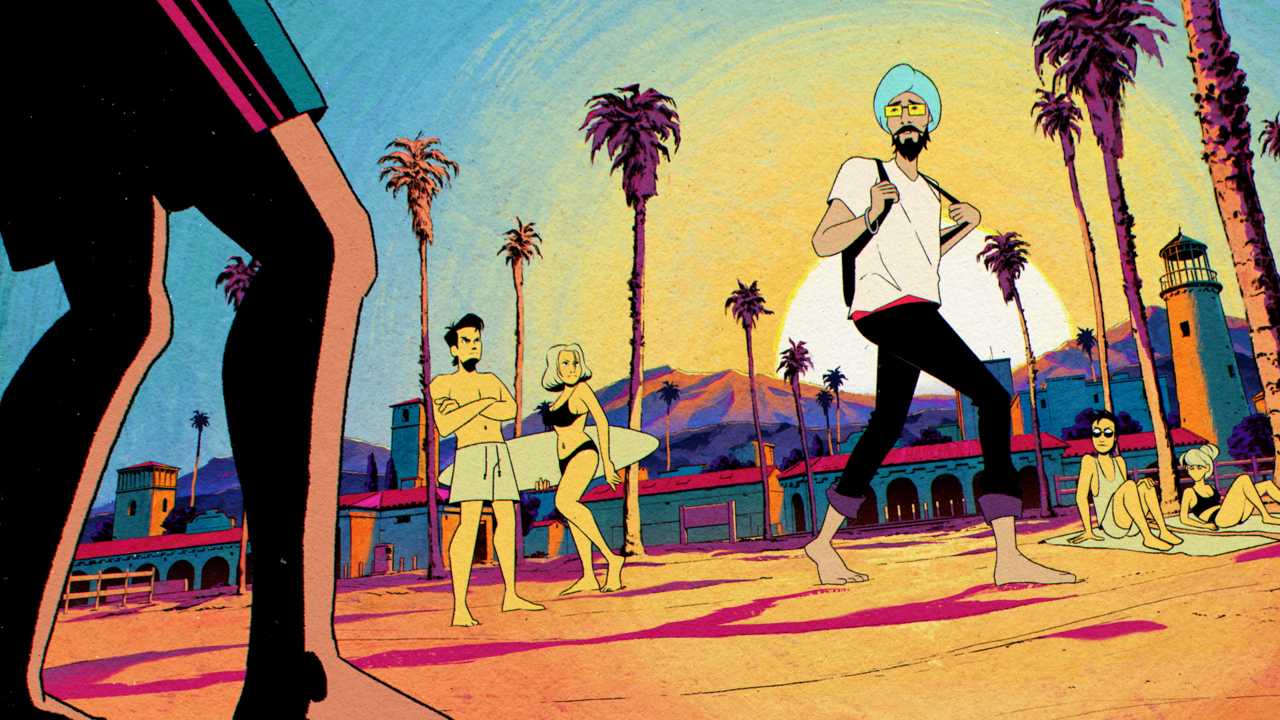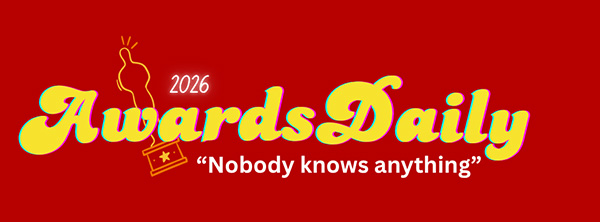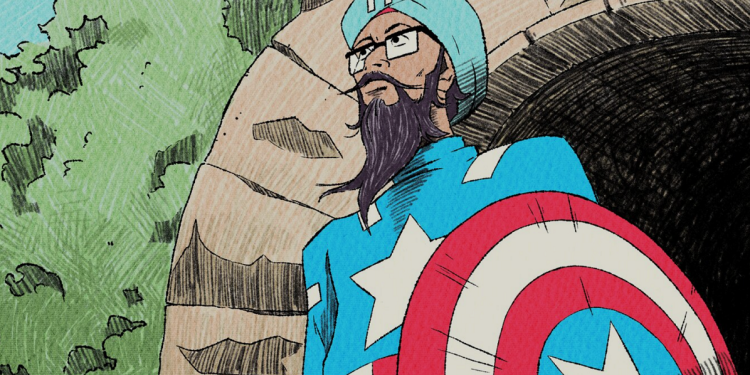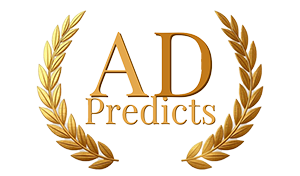“The men wore turbans…just like me…”
Those words seem like a distant memory as Vishavjit Singh recalls how the Prime Minister of India was assassinated by her two bodyguards in 1984. How people perceive someone who wears a turban is a running theme throughout American Sikh, an Animated Short Film contender directed by Singh and Ryan Westra. Sikh is a limber short that combines historical context of Singh’s life with effervescent animation. The symbol of Marvel’s Captain America is one that everyone can get behind. He stands on the principles of goodness, fairness, and doing what’s right. How would people react if a man who practices Sikhism would put on the red, white, and blue?
One of the strongest qualities is hearing Singh’s story in his own voice. Not only do we hear the emotion in his voice as he deals with the aftermath of the Prime Minister’s assassination but we hear his enthusiasm to return to America when he turned 18 and the tentativeness and fear in his voice after the attacks on the World Trade Center on September 11, 2001. Before we even see him put on a Captain America suit, the film packs in a lot of information in a swift amount of time. Being clear was important to both of these filmmakers.
“That was the biggest challenge–condensing Vishavjit’s amazing story into such a small amount of time,” Westra says. “And doing animation can be expensive. The first year and a half or two years, was me interviewing Vishavjit and figuring out a timeline and move soundbites around to best organize the information. The first cut ended up being around thirty minutes, and we had different versions of the film that got progressively shorter. We would show it to friends and our families to get feedback. By the time we approached our animation studio, we had this version storyboarded out, and from there, the only thing that got cut. There was a scene in the post-9/11 montage that we added in when Vishavjit is in Time Square and he sees the Captain America poster. There are so many emotions in this film, and that particular moment was something that we decided to give more breathing room to lead towards a more personal moment.”
“Ryan and I had worked on a live action documentary before, and he approached me in 2018 or 2019 to tell a fuller aspect of my work and my story, Singh says. “Given the two tragedies that are central to my life–both 1984 and 9/11–we determined early on that animation was a better artistic solution to showcase dark tragedy. The animation could be used to keep it lighter in sections as well. We spent so much time on the phone or sometimes I would travel to Los Angeles so Ryan to pick my brain. I joke with Ryan that besides my wife, my brother and my parents, he knows more about me than anyone else does.”
 The coloring of Sikh is very important a very intentional. I told Westra and Singh that the yellow stood out to me for how it enhanced the comic book feeling, and they detailed how the animator added and removed shades to darken and lighten the dramatic scenes. When we hear about violence against Sikhs, the palette is stark and dangers with deep blacks and blood reds.
The coloring of Sikh is very important a very intentional. I told Westra and Singh that the yellow stood out to me for how it enhanced the comic book feeling, and they detailed how the animator added and removed shades to darken and lighten the dramatic scenes. When we hear about violence against Sikhs, the palette is stark and dangers with deep blacks and blood reds.
“The yellow does pop,” Singh admits. “In my illustrating career, I planned on going to Comic-Con in New York City as an exhibitor in 2011, and, in the summer I saw the poster and I thought he should have a turban and beard. The illustration I created was informed by comics from the 1950s and 1960s–yellow background with a muscular Captain America with a long beard. That was my vision. When I think of that character, I think of those covers. I give so much credit to our animators for not being afraid to play around.”
“I’ve done some documentary films in the past, and I’ve struggled with communicating heavy, important issues in a more digestible or fun while still being respectful about the events,” Westra says. “I think what’s great about animation is that you can have that suspension of disbelief and communicate these heavy things in an engaging way. One of the ways that we can cover a lot of ground is playing with that color palette a lot. For the opening montage–the genocide of 1984–we focused on black, white, red, and blue, and then for the hate crime section after 9/11, we strip that back even further by taking out the blue. Those were the two throttles we were working with, so when we land at the parade with Vishavjit becoming Captain America, it is full of color. It is a bit of a nod to the 1950s style of comics without being too on the nose. Back in the day, there was a lot more yellow in comic books that you don’t see quite as much anymore. When we worked with our animators, I knew they were inspired by the Watchmen novel series, but they are a bit more muted in the original. They were especially excited by how Watchmen uses purple colors, and they also enjoyed not making things too realistic. Sometimes the sky will be yellow or green. If you’re going to make it animated, you may as well go for it.”
When Singh dons Captain America’s uniform for the first time, the camera scans his body in such an exciting way. The red gloves and white boots snap with urgency. The camera pans up and sound whooshes as he proudly buckles that huge star belt. The finishing touch? He wraps the turban on his head with a romantic flourish. It reminded me of the early 90’s Batman films when you knew some action was about to go down.
“A lot of the storyboards that we approached the animation studio with were nearly identical to what ended up in the film,” Westra says. “We were really aligned. With that sequence, we let the studio to really go wild and it was different to what we storyboarded–in a good way. It was loosely based on Dragonball Z [and maybe] a dash of The Power Ranger. We wanted it to be fun and dramatic to set up that we might be entering a more fun-loving area of the film.”
“What I find interesting about that sequence is the intense expression on my face,” Singh says with a chuckle. “I will pose sometimes in uniform and I will put on a fierce look. Maybe I do that more than I think? That transition is quite stark, and the music definitely helps you get into the mood for the action that’s about to happen.”
















